Comprehensive Risk Assessment Report: Healthcare Case Study Analysis
VerifiedAdded on 2022/12/28
|9
|2690
|94
Report
AI Summary
This report presents a detailed risk assessment for a healthcare setting, likely a hospice, focusing on hazard identification, risk analysis, and the prioritization of risks. It examines the background information, identifies potential hazards such as patient injuries due to unsafe practices, and analyzes possible adverse events. The report emphasizes the importance of safety culture, policies, procedures, staff training, and continuous monitoring for improvement. It also analyzes the robustness of a system for ensuring safety within the organization, including communication strategies, regulatory guidelines, and accountability measures. The document highlights the significance of risk management in healthcare to prevent harm, improve patient safety, and ensure compliance with regulations, providing a comprehensive overview of risk assessment and mitigation strategies within the healthcare environment.

Risk Assessment
Paraphrase This Document
Need a fresh take? Get an instant paraphrase of this document with our AI Paraphraser
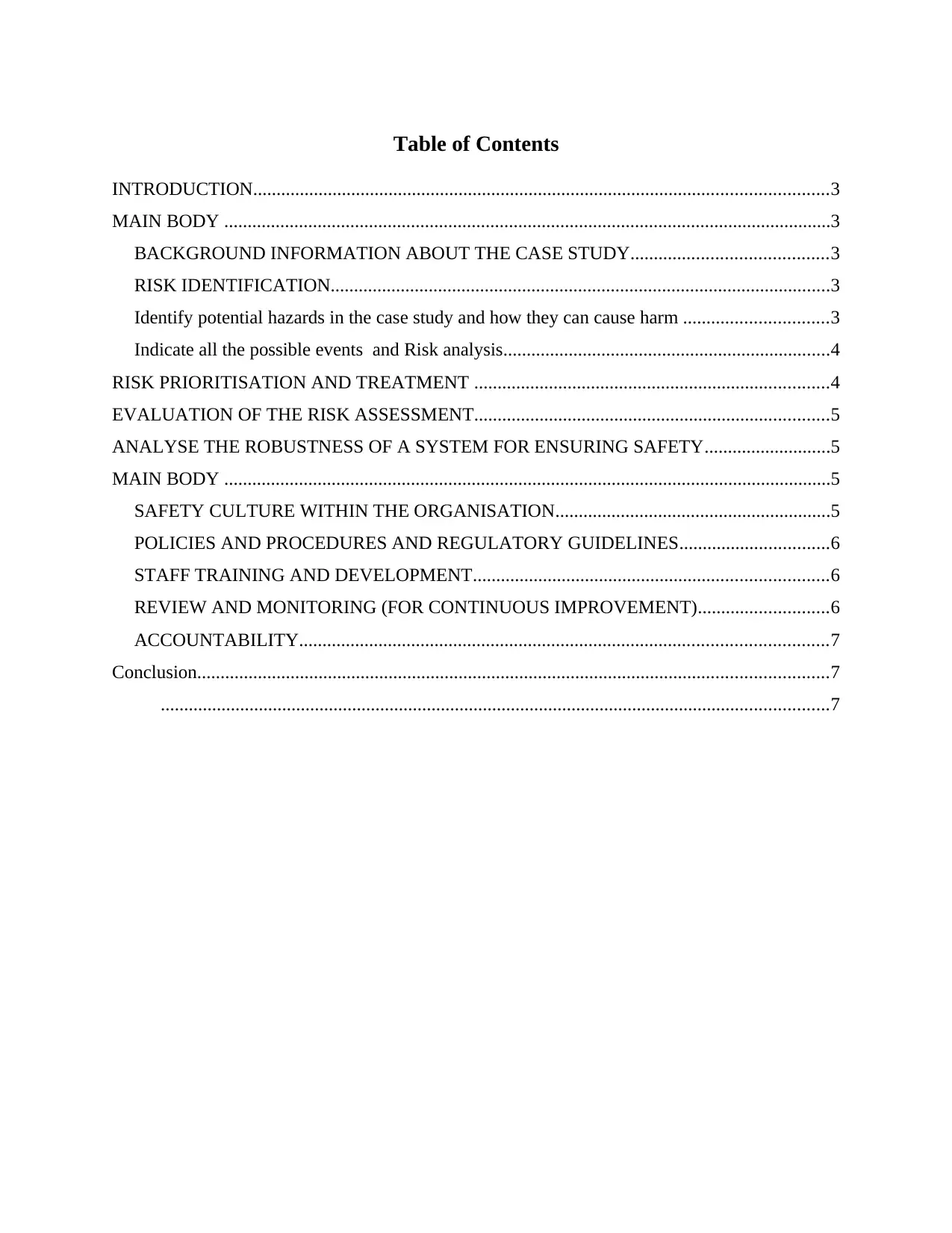
Table of Contents
INTRODUCTION...........................................................................................................................3
MAIN BODY ..................................................................................................................................3
BACKGROUND INFORMATION ABOUT THE CASE STUDY..........................................3
RISK IDENTIFICATION...........................................................................................................3
Identify potential hazards in the case study and how they can cause harm ...............................3
Indicate all the possible events and Risk analysis......................................................................4
RISK PRIORITISATION AND TREATMENT ............................................................................4
EVALUATION OF THE RISK ASSESSMENT............................................................................5
ANALYSE THE ROBUSTNESS OF A SYSTEM FOR ENSURING SAFETY...........................5
MAIN BODY ..................................................................................................................................5
SAFETY CULTURE WITHIN THE ORGANISATION...........................................................5
POLICIES AND PROCEDURES AND REGULATORY GUIDELINES................................6
STAFF TRAINING AND DEVELOPMENT............................................................................6
REVIEW AND MONITORING (FOR CONTINUOUS IMPROVEMENT)............................6
ACCOUNTABILITY.................................................................................................................7
Conclusion.......................................................................................................................................7
...............................................................................................................................................7
INTRODUCTION...........................................................................................................................3
MAIN BODY ..................................................................................................................................3
BACKGROUND INFORMATION ABOUT THE CASE STUDY..........................................3
RISK IDENTIFICATION...........................................................................................................3
Identify potential hazards in the case study and how they can cause harm ...............................3
Indicate all the possible events and Risk analysis......................................................................4
RISK PRIORITISATION AND TREATMENT ............................................................................4
EVALUATION OF THE RISK ASSESSMENT............................................................................5
ANALYSE THE ROBUSTNESS OF A SYSTEM FOR ENSURING SAFETY...........................5
MAIN BODY ..................................................................................................................................5
SAFETY CULTURE WITHIN THE ORGANISATION...........................................................5
POLICIES AND PROCEDURES AND REGULATORY GUIDELINES................................6
STAFF TRAINING AND DEVELOPMENT............................................................................6
REVIEW AND MONITORING (FOR CONTINUOUS IMPROVEMENT)............................6
ACCOUNTABILITY.................................................................................................................7
Conclusion.......................................................................................................................................7
...............................................................................................................................................7
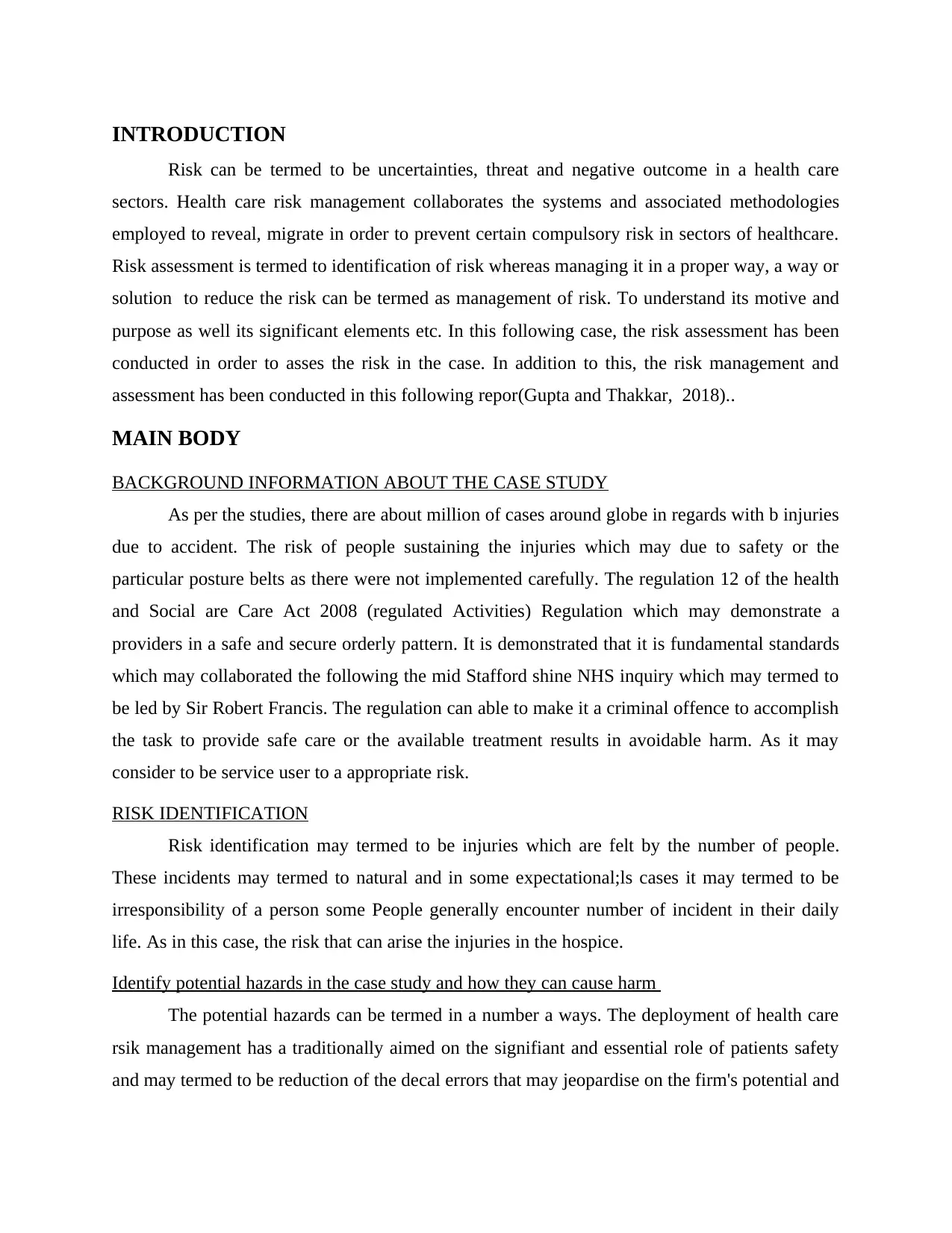
INTRODUCTION
Risk can be termed to be uncertainties, threat and negative outcome in a health care
sectors. Health care risk management collaborates the systems and associated methodologies
employed to reveal, migrate in order to prevent certain compulsory risk in sectors of healthcare.
Risk assessment is termed to identification of risk whereas managing it in a proper way, a way or
solution to reduce the risk can be termed as management of risk. To understand its motive and
purpose as well its significant elements etc. In this following case, the risk assessment has been
conducted in order to asses the risk in the case. In addition to this, the risk management and
assessment has been conducted in this following repor(Gupta and Thakkar, 2018)..
MAIN BODY
BACKGROUND INFORMATION ABOUT THE CASE STUDY
As per the studies, there are about million of cases around globe in regards with b injuries
due to accident. The risk of people sustaining the injuries which may due to safety or the
particular posture belts as there were not implemented carefully. The regulation 12 of the health
and Social are Care Act 2008 (regulated Activities) Regulation which may demonstrate a
providers in a safe and secure orderly pattern. It is demonstrated that it is fundamental standards
which may collaborated the following the mid Stafford shine NHS inquiry which may termed to
be led by Sir Robert Francis. The regulation can able to make it a criminal offence to accomplish
the task to provide safe care or the available treatment results in avoidable harm. As it may
consider to be service user to a appropriate risk.
RISK IDENTIFICATION
Risk identification may termed to be injuries which are felt by the number of people.
These incidents may termed to natural and in some expectational;ls cases it may termed to be
irresponsibility of a person some People generally encounter number of incident in their daily
life. As in this case, the risk that can arise the injuries in the hospice.
Identify potential hazards in the case study and how they can cause harm
The potential hazards can be termed in a number a ways. The deployment of health care
rsik management has a traditionally aimed on the signifiant and essential role of patients safety
and may termed to be reduction of the decal errors that may jeopardise on the firm's potential and
Risk can be termed to be uncertainties, threat and negative outcome in a health care
sectors. Health care risk management collaborates the systems and associated methodologies
employed to reveal, migrate in order to prevent certain compulsory risk in sectors of healthcare.
Risk assessment is termed to identification of risk whereas managing it in a proper way, a way or
solution to reduce the risk can be termed as management of risk. To understand its motive and
purpose as well its significant elements etc. In this following case, the risk assessment has been
conducted in order to asses the risk in the case. In addition to this, the risk management and
assessment has been conducted in this following repor(Gupta and Thakkar, 2018)..
MAIN BODY
BACKGROUND INFORMATION ABOUT THE CASE STUDY
As per the studies, there are about million of cases around globe in regards with b injuries
due to accident. The risk of people sustaining the injuries which may due to safety or the
particular posture belts as there were not implemented carefully. The regulation 12 of the health
and Social are Care Act 2008 (regulated Activities) Regulation which may demonstrate a
providers in a safe and secure orderly pattern. It is demonstrated that it is fundamental standards
which may collaborated the following the mid Stafford shine NHS inquiry which may termed to
be led by Sir Robert Francis. The regulation can able to make it a criminal offence to accomplish
the task to provide safe care or the available treatment results in avoidable harm. As it may
consider to be service user to a appropriate risk.
RISK IDENTIFICATION
Risk identification may termed to be injuries which are felt by the number of people.
These incidents may termed to natural and in some expectational;ls cases it may termed to be
irresponsibility of a person some People generally encounter number of incident in their daily
life. As in this case, the risk that can arise the injuries in the hospice.
Identify potential hazards in the case study and how they can cause harm
The potential hazards can be termed in a number a ways. The deployment of health care
rsik management has a traditionally aimed on the signifiant and essential role of patients safety
and may termed to be reduction of the decal errors that may jeopardise on the firm's potential and
⊘ This is a preview!⊘
Do you want full access?
Subscribe today to unlock all pages.

Trusted by 1+ million students worldwide
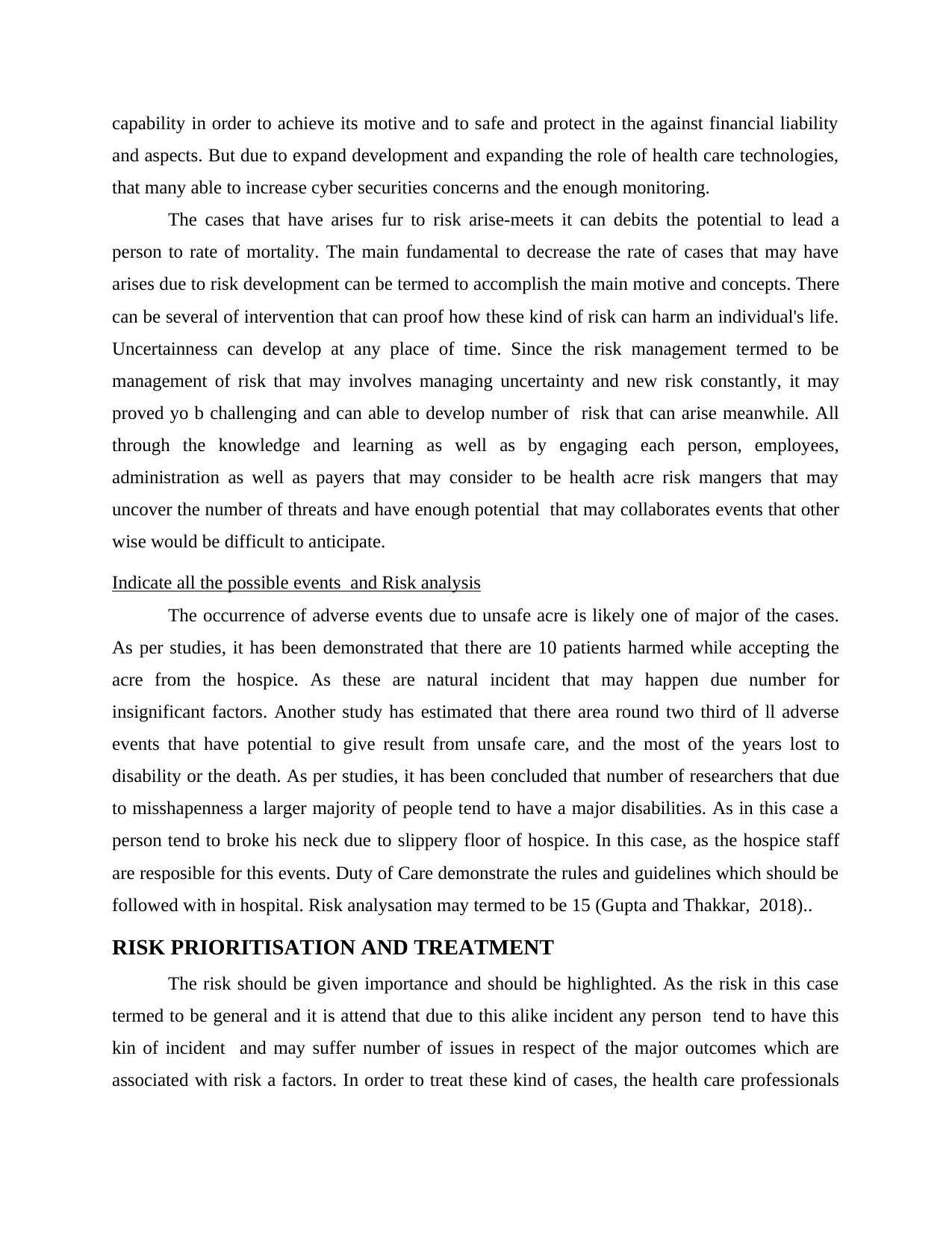
capability in order to achieve its motive and to safe and protect in the against financial liability
and aspects. But due to expand development and expanding the role of health care technologies,
that many able to increase cyber securities concerns and the enough monitoring.
The cases that have arises fur to risk arise-meets it can debits the potential to lead a
person to rate of mortality. The main fundamental to decrease the rate of cases that may have
arises due to risk development can be termed to accomplish the main motive and concepts. There
can be several of intervention that can proof how these kind of risk can harm an individual's life.
Uncertainness can develop at any place of time. Since the risk management termed to be
management of risk that may involves managing uncertainty and new risk constantly, it may
proved yo b challenging and can able to develop number of risk that can arise meanwhile. All
through the knowledge and learning as well as by engaging each person, employees,
administration as well as payers that may consider to be health acre risk mangers that may
uncover the number of threats and have enough potential that may collaborates events that other
wise would be difficult to anticipate.
Indicate all the possible events and Risk analysis
The occurrence of adverse events due to unsafe acre is likely one of major of the cases.
As per studies, it has been demonstrated that there are 10 patients harmed while accepting the
acre from the hospice. As these are natural incident that may happen due number for
insignificant factors. Another study has estimated that there area round two third of ll adverse
events that have potential to give result from unsafe care, and the most of the years lost to
disability or the death. As per studies, it has been concluded that number of researchers that due
to misshapenness a larger majority of people tend to have a major disabilities. As in this case a
person tend to broke his neck due to slippery floor of hospice. In this case, as the hospice staff
are resposible for this events. Duty of Care demonstrate the rules and guidelines which should be
followed with in hospital. Risk analysation may termed to be 15 (Gupta and Thakkar, 2018)..
RISK PRIORITISATION AND TREATMENT
The risk should be given importance and should be highlighted. As the risk in this case
termed to be general and it is attend that due to this alike incident any person tend to have this
kin of incident and may suffer number of issues in respect of the major outcomes which are
associated with risk a factors. In order to treat these kind of cases, the health care professionals
and aspects. But due to expand development and expanding the role of health care technologies,
that many able to increase cyber securities concerns and the enough monitoring.
The cases that have arises fur to risk arise-meets it can debits the potential to lead a
person to rate of mortality. The main fundamental to decrease the rate of cases that may have
arises due to risk development can be termed to accomplish the main motive and concepts. There
can be several of intervention that can proof how these kind of risk can harm an individual's life.
Uncertainness can develop at any place of time. Since the risk management termed to be
management of risk that may involves managing uncertainty and new risk constantly, it may
proved yo b challenging and can able to develop number of risk that can arise meanwhile. All
through the knowledge and learning as well as by engaging each person, employees,
administration as well as payers that may consider to be health acre risk mangers that may
uncover the number of threats and have enough potential that may collaborates events that other
wise would be difficult to anticipate.
Indicate all the possible events and Risk analysis
The occurrence of adverse events due to unsafe acre is likely one of major of the cases.
As per studies, it has been demonstrated that there are 10 patients harmed while accepting the
acre from the hospice. As these are natural incident that may happen due number for
insignificant factors. Another study has estimated that there area round two third of ll adverse
events that have potential to give result from unsafe care, and the most of the years lost to
disability or the death. As per studies, it has been concluded that number of researchers that due
to misshapenness a larger majority of people tend to have a major disabilities. As in this case a
person tend to broke his neck due to slippery floor of hospice. In this case, as the hospice staff
are resposible for this events. Duty of Care demonstrate the rules and guidelines which should be
followed with in hospital. Risk analysation may termed to be 15 (Gupta and Thakkar, 2018)..
RISK PRIORITISATION AND TREATMENT
The risk should be given importance and should be highlighted. As the risk in this case
termed to be general and it is attend that due to this alike incident any person tend to have this
kin of incident and may suffer number of issues in respect of the major outcomes which are
associated with risk a factors. In order to treat these kind of cases, the health care professionals
Paraphrase This Document
Need a fresh take? Get an instant paraphrase of this document with our AI Paraphraser
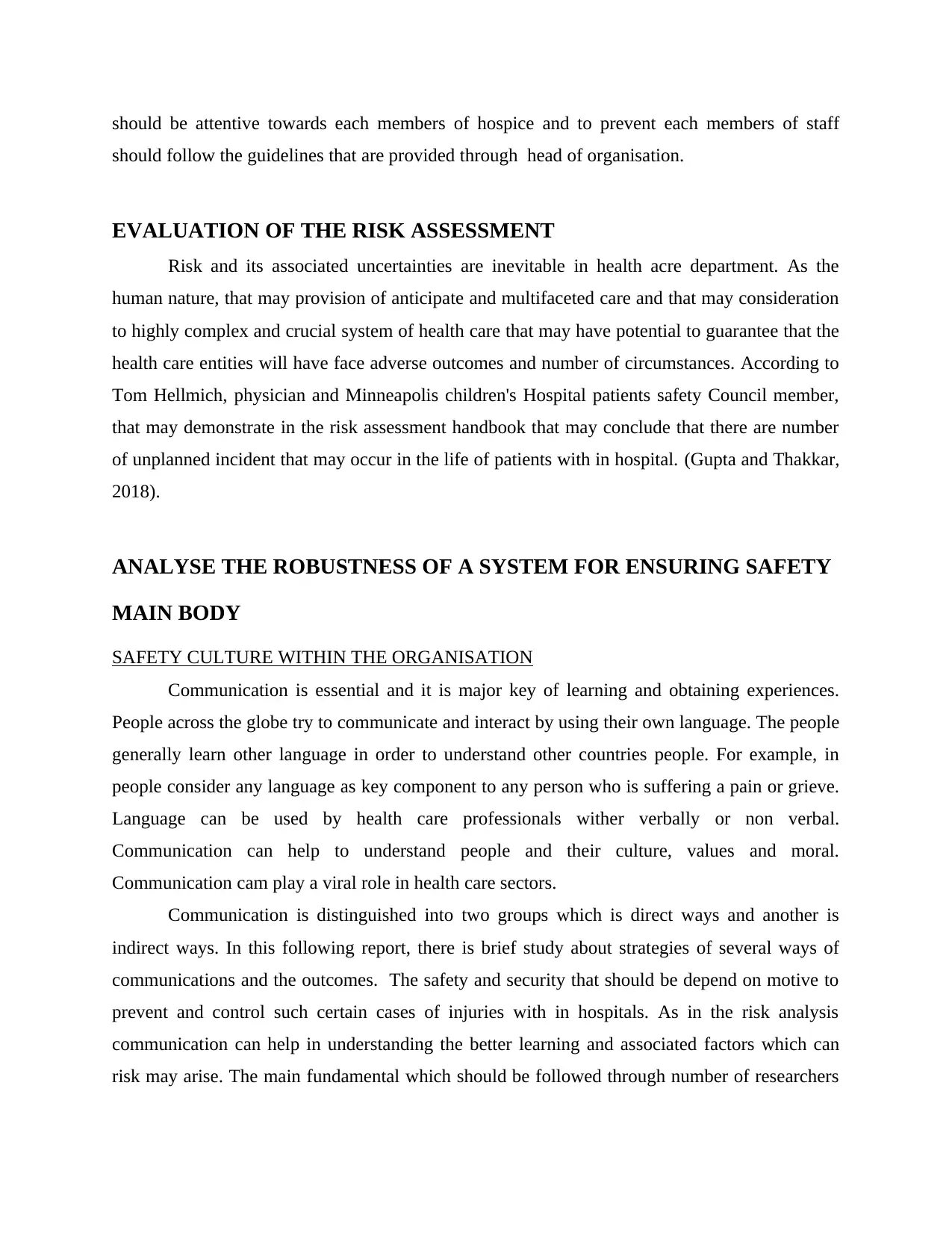
should be attentive towards each members of hospice and to prevent each members of staff
should follow the guidelines that are provided through head of organisation.
EVALUATION OF THE RISK ASSESSMENT
Risk and its associated uncertainties are inevitable in health acre department. As the
human nature, that may provision of anticipate and multifaceted care and that may consideration
to highly complex and crucial system of health care that may have potential to guarantee that the
health care entities will have face adverse outcomes and number of circumstances. According to
Tom Hellmich, physician and Minneapolis children's Hospital patients safety Council member,
that may demonstrate in the risk assessment handbook that may conclude that there are number
of unplanned incident that may occur in the life of patients with in hospital. (Gupta and Thakkar,
2018).
ANALYSE THE ROBUSTNESS OF A SYSTEM FOR ENSURING SAFETY
MAIN BODY
SAFETY CULTURE WITHIN THE ORGANISATION
Communication is essential and it is major key of learning and obtaining experiences.
People across the globe try to communicate and interact by using their own language. The people
generally learn other language in order to understand other countries people. For example, in
people consider any language as key component to any person who is suffering a pain or grieve.
Language can be used by health care professionals wither verbally or non verbal.
Communication can help to understand people and their culture, values and moral.
Communication cam play a viral role in health care sectors.
Communication is distinguished into two groups which is direct ways and another is
indirect ways. In this following report, there is brief study about strategies of several ways of
communications and the outcomes. The safety and security that should be depend on motive to
prevent and control such certain cases of injuries with in hospitals. As in the risk analysis
communication can help in understanding the better learning and associated factors which can
risk may arise. The main fundamental which should be followed through number of researchers
should follow the guidelines that are provided through head of organisation.
EVALUATION OF THE RISK ASSESSMENT
Risk and its associated uncertainties are inevitable in health acre department. As the
human nature, that may provision of anticipate and multifaceted care and that may consideration
to highly complex and crucial system of health care that may have potential to guarantee that the
health care entities will have face adverse outcomes and number of circumstances. According to
Tom Hellmich, physician and Minneapolis children's Hospital patients safety Council member,
that may demonstrate in the risk assessment handbook that may conclude that there are number
of unplanned incident that may occur in the life of patients with in hospital. (Gupta and Thakkar,
2018).
ANALYSE THE ROBUSTNESS OF A SYSTEM FOR ENSURING SAFETY
MAIN BODY
SAFETY CULTURE WITHIN THE ORGANISATION
Communication is essential and it is major key of learning and obtaining experiences.
People across the globe try to communicate and interact by using their own language. The people
generally learn other language in order to understand other countries people. For example, in
people consider any language as key component to any person who is suffering a pain or grieve.
Language can be used by health care professionals wither verbally or non verbal.
Communication can help to understand people and their culture, values and moral.
Communication cam play a viral role in health care sectors.
Communication is distinguished into two groups which is direct ways and another is
indirect ways. In this following report, there is brief study about strategies of several ways of
communications and the outcomes. The safety and security that should be depend on motive to
prevent and control such certain cases of injuries with in hospitals. As in the risk analysis
communication can help in understanding the better learning and associated factors which can
risk may arise. The main fundamental which should be followed through number of researchers

through surveys and query question that they might feel while receiving a treatments. The role of
leadership can be setting the main policies and strategies that can accomplish the motive.
POLICIES AND PROCEDURES AND REGULATORY GUIDELINES
The trust and belies that risk management is one of the important elements of
government, which basically focus or alternation and improving both clinical and non clinical
practices within the the from NHS. The well development risk management and effectiveness
incident which may able to report procedure as indemnification by department of health are
essential . The trust may knowledge the significance of collection of information and relevant
data that may able ensure that each lessons are really learned from several type of incidents that
have occur in the hospice. Inspection through National investigators may able reviews
Lord Darzi revered high quality of care for all in June 2008 which may demonstrate
patients safety, outcomes as well as effectiveness and patient experiences as being in a
fundamental to effect governance. “improving the safety of patients in England' Berwick review
the patients safety and concerns. As the level of risk is may providing the exact cost
improvement programme and re-organisation of th commissioner such landscape. As per studies,
the health care sectors is governed by the number of sets of rules and regulations, laws as well as
ethical standards. These are designed and modified in order to provide a better structure to an
organisation. The organisation termed to be follow these guideline to work in systematic way. As
the structured prosecutors can organised well to provide a quality of care, assistance an
prevention of chronic diseases of an individual. In addition to this they also help to establish
responsibilities of health care practitioners. As many author and journals do conflicted in regard
with legal and ethical issues and state that they are ten to be similar with each other (Salman,
and Li, 2018)
STAFF TRAINING AND DEVELOPMENT
As the staff training is compulsory factors in order to reduce the rate of risk cases. The
role and responsibilities of nurses, Quality and risk is to promote risk management activities
awareness and better understanding of collaborated factors that may induce the risk. As the
training is based through out trust. All members and staff have essential role to play in observing
and identification as well as minimizing risk and number of hazards that arises. As the each
leadership can be setting the main policies and strategies that can accomplish the motive.
POLICIES AND PROCEDURES AND REGULATORY GUIDELINES
The trust and belies that risk management is one of the important elements of
government, which basically focus or alternation and improving both clinical and non clinical
practices within the the from NHS. The well development risk management and effectiveness
incident which may able to report procedure as indemnification by department of health are
essential . The trust may knowledge the significance of collection of information and relevant
data that may able ensure that each lessons are really learned from several type of incidents that
have occur in the hospice. Inspection through National investigators may able reviews
Lord Darzi revered high quality of care for all in June 2008 which may demonstrate
patients safety, outcomes as well as effectiveness and patient experiences as being in a
fundamental to effect governance. “improving the safety of patients in England' Berwick review
the patients safety and concerns. As the level of risk is may providing the exact cost
improvement programme and re-organisation of th commissioner such landscape. As per studies,
the health care sectors is governed by the number of sets of rules and regulations, laws as well as
ethical standards. These are designed and modified in order to provide a better structure to an
organisation. The organisation termed to be follow these guideline to work in systematic way. As
the structured prosecutors can organised well to provide a quality of care, assistance an
prevention of chronic diseases of an individual. In addition to this they also help to establish
responsibilities of health care practitioners. As many author and journals do conflicted in regard
with legal and ethical issues and state that they are ten to be similar with each other (Salman,
and Li, 2018)
STAFF TRAINING AND DEVELOPMENT
As the staff training is compulsory factors in order to reduce the rate of risk cases. The
role and responsibilities of nurses, Quality and risk is to promote risk management activities
awareness and better understanding of collaborated factors that may induce the risk. As the
training is based through out trust. All members and staff have essential role to play in observing
and identification as well as minimizing risk and number of hazards that arises. As the each
⊘ This is a preview!⊘
Do you want full access?
Subscribe today to unlock all pages.

Trusted by 1+ million students worldwide
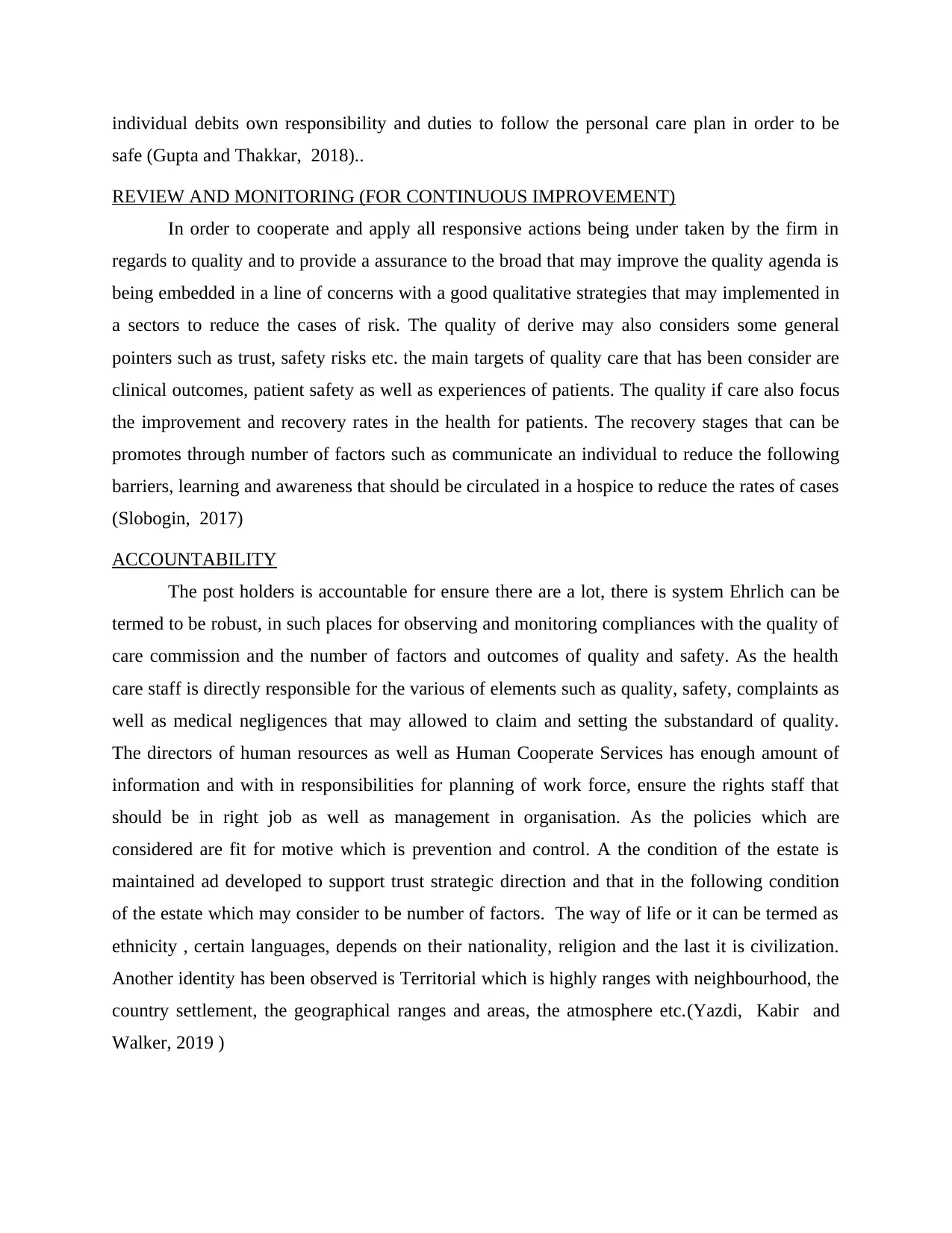
individual debits own responsibility and duties to follow the personal care plan in order to be
safe (Gupta and Thakkar, 2018)..
REVIEW AND MONITORING (FOR CONTINUOUS IMPROVEMENT)
In order to cooperate and apply all responsive actions being under taken by the firm in
regards to quality and to provide a assurance to the broad that may improve the quality agenda is
being embedded in a line of concerns with a good qualitative strategies that may implemented in
a sectors to reduce the cases of risk. The quality of derive may also considers some general
pointers such as trust, safety risks etc. the main targets of quality care that has been consider are
clinical outcomes, patient safety as well as experiences of patients. The quality if care also focus
the improvement and recovery rates in the health for patients. The recovery stages that can be
promotes through number of factors such as communicate an individual to reduce the following
barriers, learning and awareness that should be circulated in a hospice to reduce the rates of cases
(Slobogin, 2017)
ACCOUNTABILITY
The post holders is accountable for ensure there are a lot, there is system Ehrlich can be
termed to be robust, in such places for observing and monitoring compliances with the quality of
care commission and the number of factors and outcomes of quality and safety. As the health
care staff is directly responsible for the various of elements such as quality, safety, complaints as
well as medical negligences that may allowed to claim and setting the substandard of quality.
The directors of human resources as well as Human Cooperate Services has enough amount of
information and with in responsibilities for planning of work force, ensure the rights staff that
should be in right job as well as management in organisation. As the policies which are
considered are fit for motive which is prevention and control. A the condition of the estate is
maintained ad developed to support trust strategic direction and that in the following condition
of the estate which may consider to be number of factors. The way of life or it can be termed as
ethnicity , certain languages, depends on their nationality, religion and the last it is civilization.
Another identity has been observed is Territorial which is highly ranges with neighbourhood, the
country settlement, the geographical ranges and areas, the atmosphere etc.(Yazdi, Kabir and
Walker, 2019 )
safe (Gupta and Thakkar, 2018)..
REVIEW AND MONITORING (FOR CONTINUOUS IMPROVEMENT)
In order to cooperate and apply all responsive actions being under taken by the firm in
regards to quality and to provide a assurance to the broad that may improve the quality agenda is
being embedded in a line of concerns with a good qualitative strategies that may implemented in
a sectors to reduce the cases of risk. The quality of derive may also considers some general
pointers such as trust, safety risks etc. the main targets of quality care that has been consider are
clinical outcomes, patient safety as well as experiences of patients. The quality if care also focus
the improvement and recovery rates in the health for patients. The recovery stages that can be
promotes through number of factors such as communicate an individual to reduce the following
barriers, learning and awareness that should be circulated in a hospice to reduce the rates of cases
(Slobogin, 2017)
ACCOUNTABILITY
The post holders is accountable for ensure there are a lot, there is system Ehrlich can be
termed to be robust, in such places for observing and monitoring compliances with the quality of
care commission and the number of factors and outcomes of quality and safety. As the health
care staff is directly responsible for the various of elements such as quality, safety, complaints as
well as medical negligences that may allowed to claim and setting the substandard of quality.
The directors of human resources as well as Human Cooperate Services has enough amount of
information and with in responsibilities for planning of work force, ensure the rights staff that
should be in right job as well as management in organisation. As the policies which are
considered are fit for motive which is prevention and control. A the condition of the estate is
maintained ad developed to support trust strategic direction and that in the following condition
of the estate which may consider to be number of factors. The way of life or it can be termed as
ethnicity , certain languages, depends on their nationality, religion and the last it is civilization.
Another identity has been observed is Territorial which is highly ranges with neighbourhood, the
country settlement, the geographical ranges and areas, the atmosphere etc.(Yazdi, Kabir and
Walker, 2019 )
Paraphrase This Document
Need a fresh take? Get an instant paraphrase of this document with our AI Paraphraser
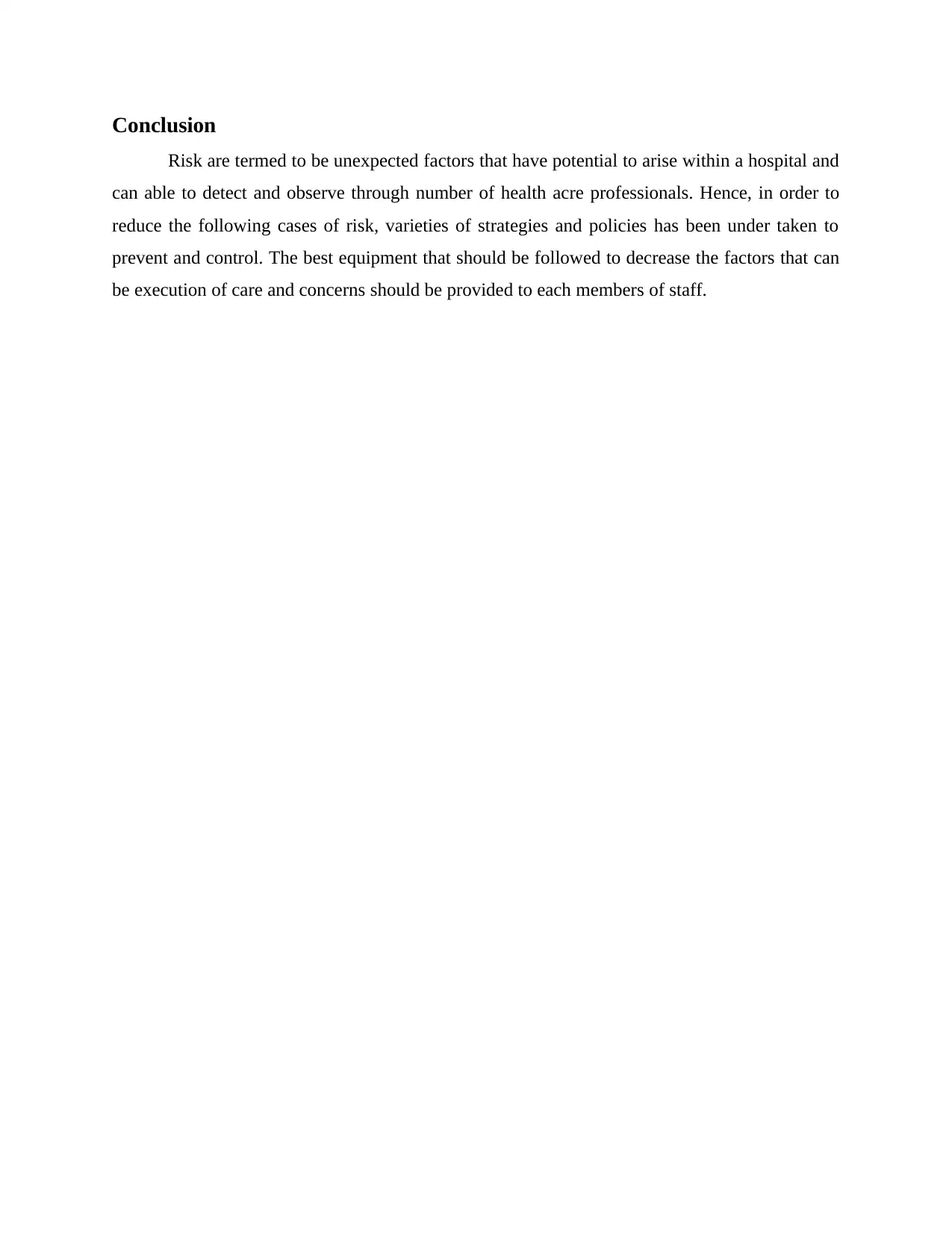
Conclusion
Risk are termed to be unexpected factors that have potential to arise within a hospital and
can able to detect and observe through number of health acre professionals. Hence, in order to
reduce the following cases of risk, varieties of strategies and policies has been under taken to
prevent and control. The best equipment that should be followed to decrease the factors that can
be execution of care and concerns should be provided to each members of staff.
Risk are termed to be unexpected factors that have potential to arise within a hospital and
can able to detect and observe through number of health acre professionals. Hence, in order to
reduce the following cases of risk, varieties of strategies and policies has been under taken to
prevent and control. The best equipment that should be followed to decrease the factors that can
be execution of care and concerns should be provided to each members of staff.

REFERENCES
book and journals
Bao, W., Lianju, N. and Yue, K., 2019. Integration of unsupervised and supervised machine
learning algorithms for credit risk assessment. Expert Systems with Applications, 128, pp.301-
315.
Bove, P., Malvindi, M.A., Kote, S.S., Bertorelli, R., Summa, M. and Sabella, S., 2017.
Dissolution test for risk assessment of nanoparticles: a pilot study. Nanoscale, 9(19), pp.6315-
6326.
Chabukdhara, M., Gupta, S.K., Kotecha, Y. and Nema, A.K., 2017. Groundwater quality in
Ghaziabad district, Uttar Pradesh, India: multivariate and health risk
assessment. Chemosphere, 179, pp.167-178.
Gupta, V.K. and Thakkar, J.J., 2018. A quantitative risk assessment methodology for
construction project. Sādhanā, 43(7), pp.1-16.
Mahajerin, A. and Croteau, S.E., 2017. Epidemiology and risk assessment of pediatric venous
thromboembolism. Frontiers in pediatrics, 5, p.68.
Oquendo, M.A. and Bernanke, J.A., 2017. Suicide risk assessment: tools and challenges. World
Psychiatry, 16(1), p.28.
Salman, A.M. and Li, Y., 2018. Flood risk assessment, future trend modeling, and risk
communication: a review of ongoing research. Natural Hazards Review, 19(3), p.04018011.
Samantra, C., Datta, S. and Mahapatra, S.S., 2017. Fuzzy based risk assessment module for
metropolitan construction project: An empirical study. Engineering Applications of Artificial
Intelligence, 65, pp.449-464.
Slobogin, C., 2017. Principles of risk assessment: Sentencing and policing. Ohio St. J. Crim.
L., 15, p.583.
Yazdi, M., Kabir, S. and Walker, M., 2019. Uncertainty handling in fault tree based risk
assessment: State of the art and future perspectives. Process Safety and Environmental
Protection, 131, pp.89-104.
book and journals
Bao, W., Lianju, N. and Yue, K., 2019. Integration of unsupervised and supervised machine
learning algorithms for credit risk assessment. Expert Systems with Applications, 128, pp.301-
315.
Bove, P., Malvindi, M.A., Kote, S.S., Bertorelli, R., Summa, M. and Sabella, S., 2017.
Dissolution test for risk assessment of nanoparticles: a pilot study. Nanoscale, 9(19), pp.6315-
6326.
Chabukdhara, M., Gupta, S.K., Kotecha, Y. and Nema, A.K., 2017. Groundwater quality in
Ghaziabad district, Uttar Pradesh, India: multivariate and health risk
assessment. Chemosphere, 179, pp.167-178.
Gupta, V.K. and Thakkar, J.J., 2018. A quantitative risk assessment methodology for
construction project. Sādhanā, 43(7), pp.1-16.
Mahajerin, A. and Croteau, S.E., 2017. Epidemiology and risk assessment of pediatric venous
thromboembolism. Frontiers in pediatrics, 5, p.68.
Oquendo, M.A. and Bernanke, J.A., 2017. Suicide risk assessment: tools and challenges. World
Psychiatry, 16(1), p.28.
Salman, A.M. and Li, Y., 2018. Flood risk assessment, future trend modeling, and risk
communication: a review of ongoing research. Natural Hazards Review, 19(3), p.04018011.
Samantra, C., Datta, S. and Mahapatra, S.S., 2017. Fuzzy based risk assessment module for
metropolitan construction project: An empirical study. Engineering Applications of Artificial
Intelligence, 65, pp.449-464.
Slobogin, C., 2017. Principles of risk assessment: Sentencing and policing. Ohio St. J. Crim.
L., 15, p.583.
Yazdi, M., Kabir, S. and Walker, M., 2019. Uncertainty handling in fault tree based risk
assessment: State of the art and future perspectives. Process Safety and Environmental
Protection, 131, pp.89-104.
⊘ This is a preview!⊘
Do you want full access?
Subscribe today to unlock all pages.

Trusted by 1+ million students worldwide
1 out of 9
Related Documents
Your All-in-One AI-Powered Toolkit for Academic Success.
+13062052269
info@desklib.com
Available 24*7 on WhatsApp / Email
![[object Object]](/_next/static/media/star-bottom.7253800d.svg)
Unlock your academic potential
Copyright © 2020–2025 A2Z Services. All Rights Reserved. Developed and managed by ZUCOL.




